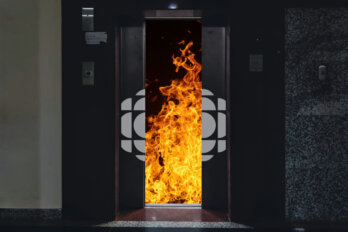From Sir John A. Macdonald to Justin Trudeau: twenty-three prime ministers, forty-two elections, forty-eight leaders of the opposition, a new country, the Riel rebellions, the building of the CPR, the burning of the Parliament buildings, national radio, two world wars, the Great Depression, television, Sputnik, the Cold War, Kennedy, the Cuban Missile Crisis, the new flag, medicare, Quebec bombings, separatism, the pollsters, Expo 67, Pierre Trudeau, the murder of Pierre Laporte, the kidnapping of a British diplomat, women’s liberation, the internet, the BlackBerry, the iPhone, terrorism, 9/11, gunshots on Parliament Hill—and more gunshots in Iraq, Afghanistan, and Syria. And, throughout, tragedy and triumph, calumny and honour.
Such is the sketch of political history for Canadians since 1867, and such is the arc of the Parliamentary press gallery and its works. Prime Minister William Lyon Mackenzie King called the gallery “an adjunct of Parliament,” and veteran Ottawa correspondent turned senator Charles Bishop once observed, “Parliament simply couldn’t function without the Gallery.” Others had a different view. One of the leading detractors was historian Frank Underhill, who denounced gallery members as “intellectually lazy and unwilling to devote the time and effort that are needed for an adequate study of the complex issues which it is their duty to report.” Whatever the view, the institution has endured. The lingering question: Does the press gallery matter anymore?
In the early days, the gallery really was a partisan adjunct, at first supporting liberal or conservative parties depending on its members’ provenances. Newspapers—and their Ottawa correspondents—were mere pawns in the hands of prime ministers.
“In those days the media did not consider themselves the opposition to the government. That role was left to the political opposition in Parliament” former public servant cabinet minister Mitchell Sharp wrote in his memoir, Which Reminds Me. Politicians and reporters were all part of the same club. When the influential Blair Fraser of Maclean’s placed a newspaper ad advising that he had lost his Irish terrier, he was surprised to get a call from Prime Minister Mackenzie King, owner of three terriers, inquiring: “Have you found your dog?”
The end of the clubby atmosphere came in 1956 when the autocratic minister of trade and commerce, C.D. Howe, tried to muscle through an $80 million loan to a US syndicate to build a pipeline that would bring Alberta gas to Toronto and Montreal. Typical of the hostile press reaction was that of the Telegram’s fiery Ottawa columnist Judith Robinson: “Clarence Decatur Howe has never shown any signs of liking Parliament. In the twenty years he has sat on a government front bench he has not learned to disguise his contempt for the slow and clumsy process by which Parliament exercises its control over the executive power.”
As historian Paul Rutherford noted, “The twin notions of investigative and adversary journalism had gained increasing favour in press circles, ever since the furious pipeline debate of 1956 had converted the press gallery into the voice of an angered opposition.” That was a sentiment reflected by the irreverent Val Sears of the Toronto Star on the eve of Prime Minister John Diefenbaker’s bid for reelection in 1962: “Come, gentlemen. We have a government to overthrow.” In the decade that followed, Canadians were served up a regular diet of investigative stories and scandals and, tellingly, rampant political instability—five elections in ten years, four of them producing minority governments.
After the disclosure by the Washington Post of the Nixon White House’s role in the Watergate burglary and cover-up in 1972, the hills were alive with imitation Woodwards and Bernsteins. In the heyday of the late 1970s and early 1980s, the CBC, the Globe and Mail, the Star, Le Devoir, La Presse, and Southam papers broke major stories on everything from Mountie barn burning to organized crime rings.
Eric Malling was one of the finest investigative reporters of his day on the CBC’s The Fifth Estate and CTV’s W5. Among his disclosures was a government cover-up of a $2 billion loss—then the largest in Canadian history—at aircraft maker Canadair. His reporting of the tainted-tuna affair in 1985 caused the resignation of the minister of fisheries who had authorized the sale of the fish over objections from his department. Malling also fronted a remarkable CTV special that celebrated efforts by New Zealand to reduce its deficit and debt with massive cuts to social programs and agricultural subsidies in 1980. Here in Canada, politicians began to wilt under the scorn of prominent business journalists and conservative think tanks that trumpeted the perils of deficit financing. These attacks ultimately gave rise to budget slashing in Ottawa and the provinces.
Yet, by 1991, slash-and-burn Malling was having second thoughts. He conceded that “Watergate envy” had caused many reporters to become contemptuous of all authority. “We have gone overboard in the notion that it’s the media’s job to criticize, to be the real opposition to whoever is in power,” he said at a University of Regina journalism symposium.
The post-Watergate era also ushered in a new journalistic puritanism. The press gallery beer machine was banished in the late 1990s, and the National Press Club closed for lack of customers. Reporters shied away from fraternizing with MPs and cabinet ministers. “This adversarial journalism,” lamented the talented Stewart MacLeod in a whimsical column for Maclean’s, “is getting entirely out of hand. It’s reached the point where you’re afraid to be seen talking to backbench politicians, let alone the Prime Minister of Canada—unless, of course, you can play a tape of everything that was said.”
Pamela Wallin also worried about the impact of television cameras trolling the halls of Parliament. “Words are never enough. I’ve got to have video,” she noted. At the time, she was the Ottawa bureau chief of CTV. And she knew that the politician who could serve up the best pictures would win the day. “There is no question our shots are visually dictated too often,” she told the Globe for a 1988 piece on the role of TV on the Hill. Doug Small, the bureau chief for Global News, added that whoever could speak in “clips” and look comfortable would get the airtime. “It’s such a crummy way to judge people,” Small conceded.
It’s also a crummy way to judge policy. The snippet became the norm. Conflict won out over content. Then, if a politician was quoted at all, it would be only a phrase to amplify the point the broadcaster was making. We often got the views of the reporter without ever knowing what actually happened at a news event. Coverage revolved around the scrums—“not a very civilized way of doing journalism,” Roger Smith once observed when he patrolled the Hill for CTV News. Conservative leader Robert Stanfield echoed the sentiment. “How silly can grown men get?” he asked during a conference on politics and the media. “We are forcing politicians to be simplistic, impressionistic and, when they succeed, to manipulate.”
Author Roy MacGregor, who spent fourteen years in the press gallery before covering the NHL for the Globe, also argues there has been “a massive cheapening of opinion.” He blames “first, social media, second, all-news format. Social media has created a world where everyone thinks their opinion has merit with the best. The field has been levelled. Everyone is a columnist, everyone an expert. And mean-minded opinion wins daily over even-handed opinion. Then you have all-news channels and the increasing reliance on panels to fill time and offer up talking heads.”
In a paper published by the Centre for International Governance Innovation, digital expert Jesse Hirsh wrote that while legacy media made room for “opposing perspectives,” social media “encourages people to connect with like minds and filter out opposing views. All space is taken up by a never-ending flow of posts and information, which makes it difficult for new or contrary ideas to emerge above the buzz of the usual suspects.”
After ever-present TV, the next major development in political reporting was the BlackBerry invasion. Christopher Waddell, former dean of journalism at Carleton and a veteran of the press gallery where he was a reporter for the Globe and bureau chief for the CBC, argued that the device was as much a curse as a blessing for political coverage.
By the 2004 election, political operatives also had BlackBerrys—and the email addresses of the reporters. Waddell argued that opening their systems to back roomers “was a fateful decision since it meant that collectively, the media had handed over its communications tool to the political parties.” What he called “BlackBerry journalism” thus became the channel for political spin 24/7, as operatives bombarded reporters with leaks, slants, and pitches.
The downside of the instant communications was that the “hacks and flacks” fell into a whirligig on Parliament Hill, chatting back and forth among themselves, often in isolation from what was happening in the country. Instead of analysis of policy, voters were treated to endless excited reports about “war rooms,” “ground games,” and “ballot questions” of little interest to the Canadian public. With the media’s insatiable maw demanding continuous updates of blogs and online reports, parties were only too willing to fire statements across the digital platform into BlackBerrys and iPhones.
Industry-wide cutbacks have also had a major impact on the quality of reporting from Ottawa. The Canadian site iPolitics reported in 2016 that the Parliamentary press gallery had shrunk to its smallest size in twenty-two years: as of December 7, 2016, there were 320 members—reporters, columnists, editors, technical staff, and camera operators—compared to the previous low of 314 in 1994. That represented almost a 20 percent drop from a peak of 379 members in only four years.
An informed media can, in Byron’s metaphor, cause “a small drop of ink, falling like dew upon a thought” to make millions think, but only if there is access to solid information. In turn, reporters chasing sensation over substance, the horse race over policies, contribute to declining faith in the legitimacy of government.
Elly Alboim, a veteran of sixteen years in TV news, including a decade as the CBC’s parliamentary-bureau chief, and a partner with the powerful Ottawa consultancy Earnscliffe, paints a glum portrait. In a 2014 policy paper, he wrote: “These days in Ottawa, competent communications advisors try to stay away from the mass media whenever they can.…They have learned that there is seldom a win to be had, that playing for ties is as good as it gets.” In an interview in spring 2016, Alboim took note of the declining investment in Ottawa news and a drop in salaries because of cuts in overtime. “People in the gallery know there is less interest at head office in what they do and less interest among the public. Covering Ottawa was once the pinnacle of a journalistic career. No longer. It is a three- or four-year stepping stone to something else.”
Torstar Corporation board chair John Honderich supports that view. Recalling with great fondness his five years in the gallery starting in 1976, he said: “Going to work in Ottawa no longer has the cachet it once had. When I was there, being a parliamentary correspondent was the top of the pecking order. That was something you would aspire to. Not so today.”
Does the decline have any impact? It is certainly true that as consumption of news has declined—and it has—there has been a striking drop in political participation. Since Pierre Trudeau was elected in 1968 and 75 percent of eligible voters went to the polls, there has been a steady erosion. The low point was the vote of 2008, which returned a Harper minority government, when voter participation fell to 59 percent. (In the 2015 election, the combination of anti-Harper feeling and Justin Trudeau’s effective campaign moved the needle up to 68.5 percent, the highest since 1993.)
Thus we end with a lament—not for a press gallery that might have been nor for some mystical golden age. Ink-stained wretches, to borrow from columnist Murray Kempton, are the kind of people who come down from the hills after the battle is over and shoot the wounded. On the other side, the fixation with control of the message has become all consuming. As former Liberal leader Bob Rae observed in his 2015 gem, What’s Happened to Politics?, “Political leaders are coiffed, dressed, managed, scripted, controlled, and presented to the public not so much as real people but as packaged products. The character and courage of the past is desperately needed today.”
In my frequent returns to the press gallery during my research before the 2015 election, I was struck by how dysfunctional Parliament Hill had become. It was all about the clip, not the substance. The reporters, arrayed in fenced pens at selected spots around the corridors, leaned in as leaders emerged to deliver their prerehearsed barbs.
The cattle pens and the slagging continued after the change of power. The challenge for government, opposition, and the media is to change that, perhaps to revive values from an earlier time. There was a day in this country when our politicians had profile and standing in their communities before they landed in Ottawa. Cabinet ministers had national reputations. You could actually name ten of them. Government MPs engaged in policy formation. If the election of 2015 meant anything, it was a clarion call for change. It highlighted the need for reporters to operate with civility, thoughtfulness, and a modicum of humility—along with skepticism—and for politicians to give up the bullhorn and the lash if they truly believe that actions and words have the power to do good. The election year of 2015 was a time to end the politics we abhor and to restore the politics we deserve. We are still waiting.
Excerpted from Power, Prime Ministers and the Press by Robert Lewis © 2018 by Robert Lewis. All rights reserved. Published by Dundurn Press.





